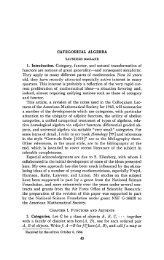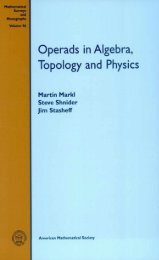Symmetric Monoidal Categories for Operads - Index of
Symmetric Monoidal Categories for Operads - Index of
Symmetric Monoidal Categories for Operads - Index of
Create successful ePaper yourself
Turn your PDF publications into a flip-book with our unique Google optimized e-Paper software.
140 10 Miscellaneous Examples<br />
10.1.1 Shifted <strong>Operads</strong>. Recall that the shifted operad R[ · ] consists <strong>of</strong> the<br />
collection <strong>of</strong> objects R[m](n) =R(m + n), m, n ∈ N.<br />
In §4.1.4, we use the action <strong>of</strong> Σn on {m +1,...,m+ n} ⊂{1,...,m+ n}<br />
to define an action <strong>of</strong> Σn on R(m + n), <strong>for</strong> every n ∈ N, and to give to the<br />
collection R[m](n), n ∈ N, the structure <strong>of</strong> a Σ∗-object. In the case <strong>of</strong> an<br />
operad, the composites at last positions<br />
R(r + s) ⊗ R(n1) ⊗···⊗R(ns) → R(r + n1 + ···+ ns)<br />
(insert operad units η : 1 → R(1)atpositions1,...,r) provide each object<br />
R[r], r ∈ N, with the additional structure <strong>of</strong> a right R-module.<br />
In §4.1.5, we also observe that the collection {R[r]}r∈N is equipped with<br />
the structure <strong>of</strong> an operad: the action <strong>of</strong> Σm on {1,...,m}⊂{1,...,m+ n}<br />
determines an action <strong>of</strong> Σm on R[m](n) =R(m + n), <strong>for</strong> every m, n ∈ N, and<br />
we use operadic composites at first positions<br />
R(r + s) ⊗ R(m1 + n1) ⊗···⊗R(mr + nr) → R(m1 + n1 + ···+ mr + nr + s)<br />
together with the action <strong>of</strong> appropriate bloc permutations<br />
R(m1 + n1 + ···+ mr + nr + s) � −→ R(m1 + ···+ mr + n1 + ···+ nr + s)<br />
to define composition products:<br />
R[r] ⊗ R[m1] ⊗···⊗R[mr] → R[m1 + ···+ mr].<br />
The axioms <strong>of</strong> operads (in May’s <strong>for</strong>m) imply immediately that the action <strong>of</strong><br />
permutations w ∈ Σm preserves the internal right R-module structure <strong>of</strong> R[m]<br />
and similarly regarding the composition products <strong>of</strong> R[ · ]. Finally, we obtain<br />
that the collection {R[r]}r∈N <strong>for</strong>ms an operad in the symmetric monoidal<br />
category <strong>of</strong> right R-modules.<br />
The morphism <strong>of</strong> §4.1.6<br />
η : R → R[ · ],<br />
which identifies R(m) with the constant part <strong>of</strong> R[m], <strong>for</strong>ms a morphism <strong>of</strong><br />
operads in right R-modules.<br />
In the sequel, we use the notation OR to refer to the category <strong>of</strong> operads<br />
in right R-modules, and the notation R / OR to refer to the comma category<br />
<strong>of</strong> objects under R ∈O, where we identify the objects P(m) underlying an<br />
operad P ∈Owith constant right R-modules to <strong>for</strong>m a functor O→OR. Our<br />
definition makes the operad R[ · ] an object <strong>of</strong> this category R/OR.<br />
10.1.2 Functors on <strong>Operads</strong>. In §4.1.5, we use that S : M ↦→ S(M) defines<br />
a functor <strong>of</strong> symmetric monoidal categories S : M→F to obtain that the<br />
collection {S(R[r],X)}r∈N, associated to any object X ∈E, <strong>for</strong>ms an operad<br />
in E. We obtain similarly that the collection {SR(R[r],A)}r∈N, associatedto<br />
any R-algebra A ∈ RE, <strong>for</strong>ms an operad in E.






